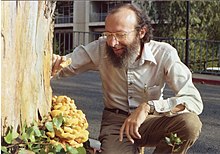This is an old revision of this page, as edited by DuncanHill (talk | contribs) at 18:26, 15 August 2023 (Does this work?). The present address (URL) is a permanent link to this revision, which may differ significantly from the current revision.
Revision as of 18:26, 15 August 2023 by DuncanHill (talk | contribs) (Does this work?)(diff) ← Previous revision | Latest revision (diff) | Newer revision → (diff) American mathematical statistician and mycologist| Jack Carl Kiefer | |
|---|---|
 Jack Kiefer in 1979 Jack Kiefer in 1979 | |
| Born | (1924-01-25)January 25, 1924 Cincinnati, Ohio, USA |
| Died | August 10, 1981(1981-08-10) (aged 57) Berkeley, California, USA |
| Education | MIT Columbia University |
| Scientific career | |
| Institutions | Cornell University University of California, Berkeley |
| Doctoral advisor | Abraham Wald Jacob Wolfowitz |
| Doctoral students | Lawrence D. Brown Ker-Chau Li |
Jack Carl Kiefer (January 25, 1924 – August 10, 1981) was an American mathematical statistician at Cornell University (1952 to 1979) and the University of California, Berkeley (1979 to 1981). His research interests included the optimal design of experiments, which was his major research area, as well as a wide variety of topics in mathematical statistics.
Biography
Jack Kiefer was born in Cincinnati, Ohio, to Carl Jack Kiefer and Marguerite K. Rosenau. He began his undergraduate studies at the Massachusetts Institute of Technology in 1942, but left after one year, taking up a position as first lieutenant in the United States Air Force during World War II. In 1946, he returned to MIT, graduating with bachelor's and master's degrees in economics and engineering in 1948 under the supervision of Harold Freeman. He then began graduate studies at Columbia University, under the supervision of Abraham Wald and Jacob Wolfowitz, receiving his Ph.D. in mathematical statistics in 1952. While still a graduate student, he began teaching at Cornell University, remaining there until 1979, when he retired from Cornell and accepted a new position as Miller Research Professor in the Department of Statistics and Mathematics at the University of California, Berkeley. In 1957, he married Dooley Sciple, a former undergraduate student of his at Cornell, with whom he had two children. Kiefer died of a heart attack in Berkeley, California on August 10, 1981.
Awards and honors
Kiefer was a Fellow of the American Statistical Association and of the Institute of Mathematical Statistics, a member of the American Academy of Arts and Sciences (elected 1972) and of the United States National Academy of Sciences (elected 1975). From 1969–1970 he was president of the Institute of Mathematical Statistics. In 1973, Kiefer and Michael Fisher were the first two Cornell faculty elected as Horace White Professors.
Contributions
Much of Kiefer's research was on the design of experiments; the American Statistician obituary calls him "undoubtedly the foremost worker in optimal experimental design". However, he also made significant contributions to other areas of statistics and optimization, including the introduction of golden section search (his master's thesis work) the Dvoretzky–Kiefer–Wolfowitz inequality and the Bahadur-Ghosh-Kiefer representation (with R. R. Bahadur and J. K. Ghosh).
See also
- Kiefer–Wolfowitz algorithm
- Hoeffding's independence test
- Strong subadditivity of quantum entropy
- Information-based complexity
Notes
- ^ Bechhofer 1982; O'Connor & Robertson.
- 2 Professors Are Named To Horace White Chairs, Cornell Chronicle, vol. 4, no. 19, Feb. 22, 1973. Page 3. Retrieved May 30, 2011.
- Wynn 1984.
- Brown 1984
- Lahiri, S. N (1992). "On the Bahadur—Ghosh—Kiefer representation of sample quantiles". Statistics & Probability Letters. 15 (2): 163–168. doi:10.1016/0167-7152(92)90130-w.
References
- Bechhofer, R. (1982), "Jack Carl Kiefer 1924–1981", The American Statistician, 36 (4): 356–357, doi:10.1080/00031305.1982.10483047, JSTOR 2683084.
- Brown, Lawrence D.; Olkin, Ingram; Sacks, J.; Wynn, H. P. (1985), Jack Carl Kiefer: Collected Papers, Vols. I, II, III, Springer-Verlag, ISBN 978-0-387-96003-6. Reviewed in Biometrics 43 (1): 257.
- Brown, Lawrence D. (1984), "The research of Jack Kiefer outside the area of experimental design", Annals of Statistics, 12 (2): 406–415, doi:10.1214/aos/1176346495.
- O'Connor, John J.; Robertson, Edmund F., "Jack Kiefer", MacTutor History of Mathematics Archive, University of St Andrews
- Sacks, Jerome (1984), "Jack Carl Kiefer 1924–1981", Annals of Statistics, 12 (2): 403–405, doi:10.1214/aos/1176346494.
- Wynn, Henry P. (1984), "Jack Kiefer's contributions to experimental design", Annals of Statistics, 12 (2): 416–423, doi:10.1214/aos/1176346496.
- "The publications and writings of Jack Kiefer", Annals of Statistics, 12 (2): 424–430, 1984, doi:10.1214/aos/1176346497.
- Presidents of the Institute of Mathematical Statistics
- Fellows of the American Statistical Association
- Fellows of the Institute of Mathematical Statistics
- American statisticians
- Cornell University faculty
- University of California, Berkeley College of Letters and Science faculty
- Columbia Graduate School of Arts and Sciences alumni
- Massachusetts Institute of Technology alumni
- 1924 births
- 1981 deaths
- Members of the United States National Academy of Sciences
- 20th-century American mathematicians
- Mathematical statisticians
- People from Cincinnati